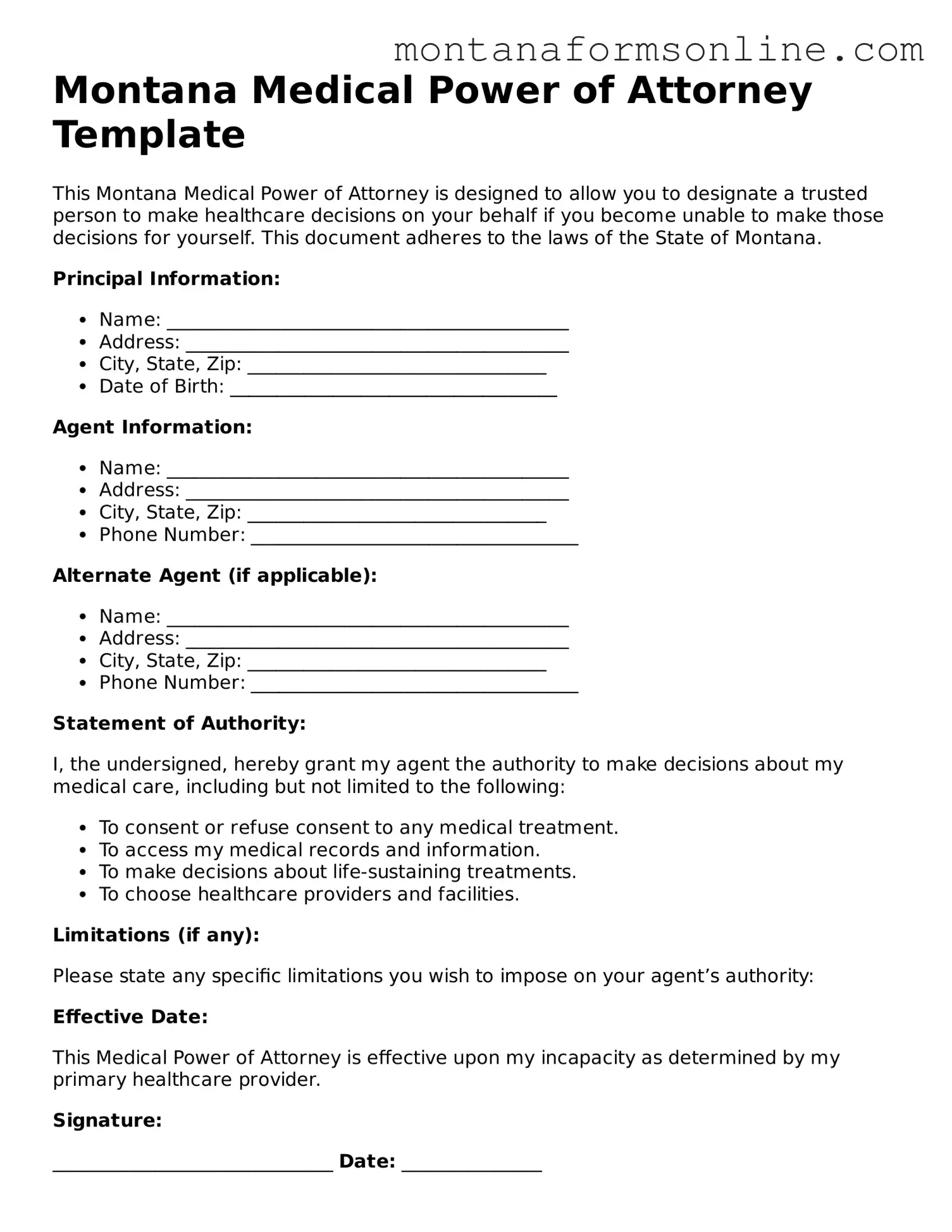The Montana Medical Power of Attorney form shares similarities with the Durable Power of Attorney. Both documents allow individuals to designate someone to make decisions on their behalf. However, while the Durable Power of Attorney can cover a broad range of financial and legal matters, the Medical Power of Attorney specifically focuses on healthcare decisions. This distinction is critical, as it ensures that the appointed agent has the authority to make medical choices when the principal is unable to do so.
Another document akin to the Montana Medical Power of Attorney is the Living Will. A Living Will outlines an individual's preferences regarding medical treatment in situations where they cannot communicate their wishes. While the Medical Power of Attorney designates an agent to make decisions, the Living Will provides specific instructions about the types of treatment the individual does or does not want. Together, these documents can provide comprehensive guidance for healthcare providers.
In the realm of estate planning, understanding the various legal documents is crucial for ensuring that your wishes are fulfilled. A vital resource for this knowledge is TopTemplates.info, where individuals can find relevant templates and guidance on creating critical documents like the Last Will and Testament, which helps delineate asset distribution and guardianship after one's passing.
The Health Care Proxy is also similar to the Montana Medical Power of Attorney. This document allows a person to appoint a healthcare agent to make medical decisions on their behalf. The primary difference lies in the terminology and specific legal requirements that may vary by state. Nonetheless, both documents serve the same fundamental purpose: ensuring that an individual's healthcare preferences are honored when they are unable to voice them.
The Advance Directive is another document that aligns closely with the Montana Medical Power of Attorney. An Advance Directive encompasses both the Medical Power of Attorney and the Living Will, providing a comprehensive approach to healthcare decision-making. This document allows individuals to outline their medical treatment preferences and designate an agent, making it a powerful tool for managing one's healthcare wishes.
The Do Not Resuscitate (DNR) order is similar in that it addresses specific medical treatment preferences. A DNR order indicates that a person does not wish to receive cardiopulmonary resuscitation (CPR) in the event of cardiac arrest. While the Montana Medical Power of Attorney allows for broader healthcare decisions, a DNR focuses on a specific scenario. Both documents reflect the individual's wishes regarding life-sustaining treatment.
The Physician Orders for Life-Sustaining Treatment (POLST) form also bears resemblance to the Montana Medical Power of Attorney. This form translates an individual's healthcare preferences into actionable medical orders. Unlike the Medical Power of Attorney, which designates an agent, the POLST form provides specific instructions for healthcare providers regarding life-sustaining treatments. Both documents aim to ensure that an individual's wishes are respected during medical emergencies.
The Guardianship document is another related legal form. While the Montana Medical Power of Attorney pertains specifically to healthcare decisions, a Guardianship involves a court-appointed individual who makes decisions on behalf of someone who is unable to care for themselves. The scope of a Guardianship is broader, covering personal, financial, and medical decisions, whereas the Medical Power of Attorney is limited to healthcare matters.
The Revocation of Power of Attorney is also relevant. This document allows an individual to cancel a previously granted power of attorney, including a Medical Power of Attorney. It ensures that the appointed agent no longer has the authority to make healthcare decisions. The Revocation serves as a safeguard, enabling individuals to change their preferences regarding who can make medical decisions on their behalf.
Lastly, the Consent to Treatment form is similar in that it involves the authorization of medical treatment. This document is often used in specific medical situations, granting healthcare providers permission to administer treatment. While the Montana Medical Power of Attorney designates an agent to make decisions, the Consent to Treatment is a direct agreement between the patient and the healthcare provider, focusing on immediate medical care rather than long-term decision-making.
